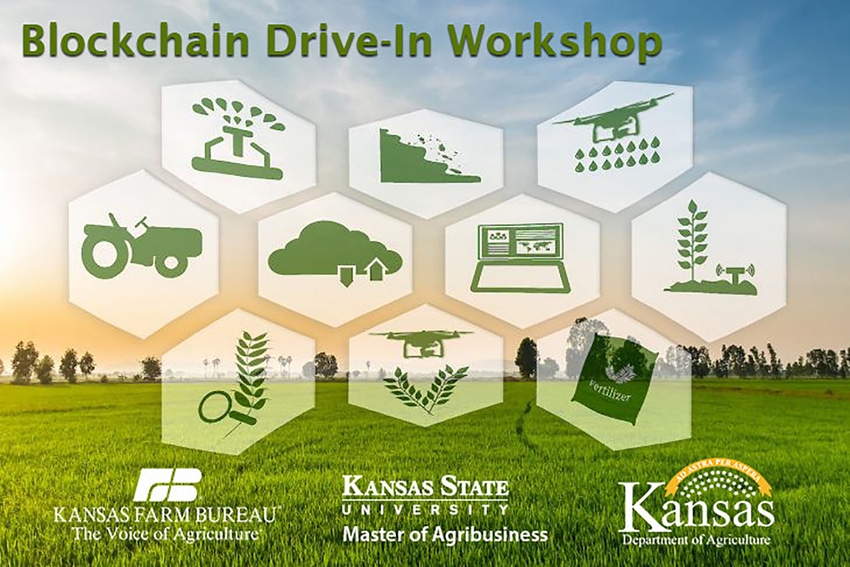Could the pork industry benefit from blockchain?
For traceability from pig to pork chop, the biggest challenge is when pigs go to the processing plant.
December 10, 2018

Source: Kansas State University Research and Extension
What do pork and beef producers, food companies, and bankers have in common? Some of them are exploring how a relatively new way of keeping data, called blockchain, can help their businesses and industries.
“Blockchain is really just a database,” says Andy Brudtkuhl, director of emerging technology with the National Pork Board. He spoke recently to participants at a workshop sponsored by Kansas State University’s Master of Agribusiness program, Kansas Department of Agriculture and Kansas Farm Bureau.
Brudtkuhl is researching the impacts and implications of the technology applied to the food supply chain and specifically, how it can benefit pork producers.
Blockchain is a list of digital records, called blocks that are linked using cryptography. Each block contains a string of numbers and letters produced by a mathematical function – called a cryptographic hash – related to the previous block, a timestamp and transaction data. By design, it’s difficult to modify. Once recorded, the data in any given block cannot be altered retroactively without alteration of the subsequent blocks.
Blockchain technology was invented in 2008 by an unknown person using the name Satoshi Nakamoto to serve as the public transaction ledger of the cryptocurrency bitcoin, but since then other industries have explored its use.
The chain in blockchain works by referencing the previous block’s hash, Brudtkuhl says. There’s a certain amount of trust built in because everyone involved has a copy, and the system is designed so if someone removed a block, it would be easily discovered.
Currently, supply chains rely largely on trust, he says, noting that blockchain technology could increase transparency, keep records from being changed (immutable), increase traceability and improve efficiency.
“Blockchain doesn’t solve the problem, it just helps the problem,” he says, noting that Walmart is using blockchain technology to track the leafy greens it purchases.
In a letter to its suppliers of leafy greens in September, Walmart said that to increase food traceability and transparency and to create shared value for the entire leafy green farm-to-table continuum, it has launched a new, blockchain-enabled Walmart Food Traceability Initiative. The move, the letter stated, means “all fresh leafy greens suppliers are expected to be able to trace their products back to farm(s) (by production lot) in seconds – not days.”
Brudtkuhl says that as Walmart creates rules for other food suppliers, pork producers want to be involved in the discussion.
For traceability from pig to pork chop, the biggest challenge is when pigs go to the processing plant, he says, noting that eventually, DNA evidence might be used.
BeefChain
“Right now, a consumer has no idea what steps (a beef) product has been through, and a producer has no idea where their product ends up,” says Tyler Lindholm, chief of ranching operations with BeefChain, a new “rancher-centric” supply chain using blockchain technology. Lindholm is a Wyoming rancher and chairman of the Wyoming Blockchain Task Force. He is also a Wyoming state representative.
He said he believes that movement toward use of such technology should be producer-driven rather than government-driven, and that Walmart’s move with its suppliers of leafy greens signals that it likely will move in that direction for its meat suppliers, too.
Such moves will come at a cost, Lindholm added, but higher premiums for enabling unique animal identification and ensuring origin traceability allows ranchers to receive premium pricing for their beef and provides consumers with greater confidence in the meat they consume.
Food companies and bankers
Rachel Gabato, products and program manager with New York- and San Francisco-based company Ripe.io says some companies are using sensors that capture data along the food supply chain, which adds more layers of information, starting with the farmer and all the way through harvest, transport, processing and retail. In that way, it’s possible to learn how temperature, for example, affects a product.
If tomatoes go bad between a farmer’s field and a retail store, this emerging technology may make it easier to see where the temperature inside a truck was below optimal, for instance.
“This is relatively new technology for the (food) industry,” Gabato says, and can help solve problems and lead to less finger-pointing.
“We’ve had a lot of inquiries from our customers about blockchain,” says Tanner Ehmke, manager of CoBank’s Knowledge Exchange, adding that CoBank is investigating the new technology and how it and its customers might use it. CoBank is a lender to agricultural, power, water and communications businesses.
“New technologies continue to offer a more reliable, efficient, and safe food system,” says Allen Featherstone, head of the Kansas State University Department of Agricultural Economics. “The objective of the workshop was to help demystify the blockchain technology. Those objectives were accomplished. We plan to provide another workshop on an emerging issue in the agricultural and food industry during the fall of 2019.”
You May Also Like



